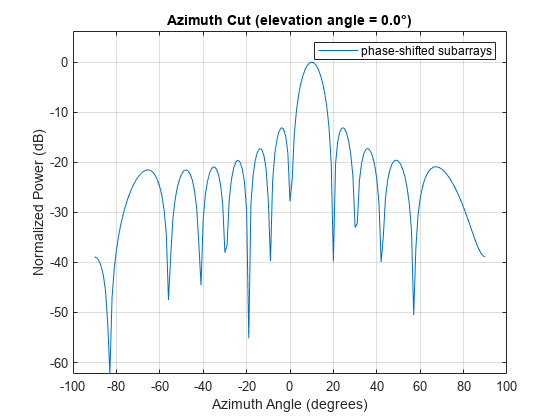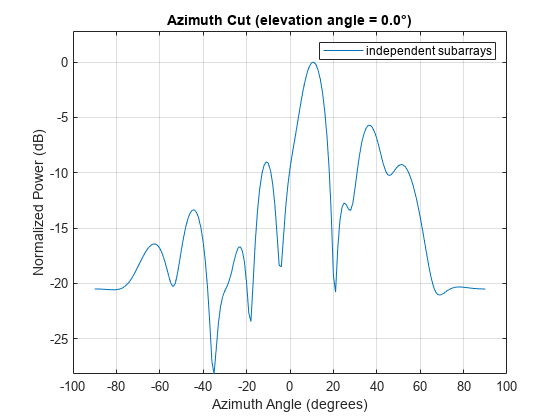phased.ReplicatedSubarray.step
Output responses of subarrays
Description
Note
The object performs an initialization the first time the object is executed. This
initialization locks nontunable properties
and input specifications, such as dimensions, complexity, and data type of the input data.
If you change a nontunable property or an input specification, the System object™ issues an error. To change nontunable properties or inputs, you must first
call the release method to unlock the object.
Examples
Subarray Response
Calculate the response at boresight for two 2-element ULA arrays that form subarrays of a 4-element ULA array of short-dipole antenna elements.
Create a two-element ULA of short-dipole antenna elements. Then, arrange two copies to form a 4-element ULA.
antenna = phased.ShortDipoleAntennaElement; array = phased.ULA('Element',antenna,'NumElements',2,'ElementSpacing',0.5); replicatedarray = phased.ReplicatedSubarray('Subarray',array,... 'Layout','Rectangular','GridSize',[1 2],... 'GridSpacing','Auto');
Find the response of each subarray at boresight. Assume the operating frequency is 1 GHz and the wave propagation speed is the speed of light.
c = physconst('LightSpeed');
resp = replicatedarray(1.0e9,[0;0],c)resp = struct with fields:
H: [2x1 double]
V: [2x1 double]
Independently Steered Replicated Subarrays
Create an array consisting of three copies of a 4-element ULA having elements spaced 1/2 wavelength apart. The array operates at 300 MHz.
c = physconst('LightSpeed');
fc = 300e6;
lambda = c/fc;
subarray = phased.ULA(4,0.5*lambda);Steer all subarrays by a common phase shift to 10 degrees azimuth.
array = phased.ReplicatedSubarray('Subarray',subarray,'GridSize',[1 3], ... 'SubarraySteering','Phase','PhaseShifterFrequency',fc); steer_ang = [10;0]; sv_array = phased.SteeringVector('SensorArray',array,... 'PropagationSpeed',c); wts_array = sv_array(fc,steer_ang); pattern(array,fc,-90:90,0,'CoordinateSystem','Rectangular',... 'Type','powerdb','PropagationSpeed',c,'Weights',wts_array,... 'SteerAngle',steer_ang); legend('phase-shifted subarrays')

Compute independent subarray weights from subarray steering vectors. The weights point to 5, 15, and 30 degrees azimuth. Set the SubarraySteering property to 'Custom'.
steer_ang_subarrays = [5 15 30;0 0 0]; sv_subarray = phased.SteeringVector('SensorArray',subarray,... 'PropagationSpeed',c); wc = sv_subarray(fc,steer_ang_subarrays); array.SubarraySteering = 'Custom'; pattern(array,fc,-90:90,0,'CoordinateSystem','Rectangular',... 'Type','powerdb','PropagationSpeed',c,'Weights',wts_array,... 'ElementWeight',conj(wc)); legend('independent subarrays') hold off

Input Arguments
H — Replicated subarray
phased.ReplicatedSubarray System
object (default)
Phased array formed by replicated subarrays.
FREQ — Operating frequencies
length L row vector
Operating frequencies of array. FREQ is a row vector
of length L. Typical values are within the range specified by a property of
H.Subarray.Element. That property is named
FrequencyRange or FrequencyVector,
depending on the type of element in the array. The element has zero response
at frequencies outside that range. Units are in Hz.
Example: [3.0e6 3.2e6]
Data Types: double
ANG — Direction angles
real-valued length-M row vector | real-valued 2-by-M matrix
Directions in degrees. ANG can be either a 2-by-M
matrix or a row vector of length M.
If ANG is a 2-by-M matrix, each column of the matrix
specifies the direction in the form [azimuth; elevation]. The azimuth angle
must be between –180 and 180 degrees, inclusive. The elevation angle must be
between –90 and 90 degrees, inclusive.
If ANG is a row vector of length M, each element
specifies a direction’s azimuth angle. In this case, the corresponding
elevation angle is assumed to be 0.
Example: [10 11 12]
Data Types: double
V — Propagation speed
positive scalar
Propagation speed in meters per second. This value must be a scalar.
Example: physconst('LightSpeed')
Data Types: double
STEERANGLE — Steer angles
scalar (default) | real-valued 2-element column vector
Subarray steering direction. STEERANGLE can be either
a 2-element column vector or a scalar.
If this argument is a 2-element column vector, it has the form [azimuth; elevation]. The azimuth angle must be between –180° and 180°, inclusive. The elevation angle must be between –90° and 90°, inclusive.
If STEERANGLE is a scalar, it specifies the
direction’s azimuth angle. In this case, the elevation angle is assumed to
be 0°.
Example: [20;-30]
Dependencies
To enable this argument, set the SubarraySteering
to 'Phase' or 'Time'.
Data Types: double
WS — Subarray element weights
complex-valued
NSE-by-N
matrix
Subarray element weights
Subarray element weights, specified as complex-valued NSE-by-N matrix. Weights are applied to the individual elements within a subarray. All subarrays have the same dimensions and sizes. NSE is the number of elements in each subarray and N is the number of subarrays. Each column of the matrix specifies the weights for the corresponding subarray.
Dependencies
To enable this argument, set the SubarraySteering
to 'Custom'.
Data Types: double
Complex Number Support: Yes
Output Arguments
RESP — Voltage response
complex-valued
N-by-M-by-L
array | struct
Voltage responses of the subarrays of the phased array. The output depends on whether the array supports polarization or not.
If the array is not capable of supporting polarization, the voltage response,
RESP, has the dimensions N-by-M-by-L. The first dimension, N , represents the number of subarrays in the phased array, the second dimension, M, represents the number of angles specified inANG, while L represents the number of frequencies specified inFREQ. Each column ofRESPcontains the responses of the subarrays for the corresponding direction specified inANG. Each of the L pages ofRESPcontains the responses of the subarrays for the corresponding frequency specified inFREQ.If the array is capable of supporting polarization, the voltage response,
RESP, is a MATLAB®structcontaining two fields,RESP.HandRESP.V, each having dimensions N-by-M-by-L. The field,RESP.H, represents the array’s horizontal polarization response, whileRESP.Vrepresents the array’s vertical polarization response. The first dimension, N , represents the number of subarrays in the phased array, the second dimension, M, represents the number of angles specified inANG, while L represents the number of frequencies specified inFREQ. Each of the M columns contains the responses of the subarrays for the corresponding direction specified inANG. Each of the L pages contains the responses of the subarrays for the corresponding frequency specified inFREQ.
Data Types: double
Complex Number Support: Yes
Version History
Introduced in R2012a
See Also
MATLAB Command
You clicked a link that corresponds to this MATLAB command:
Run the command by entering it in the MATLAB Command Window. Web browsers do not support MATLAB commands.

Select a Web Site
Choose a web site to get translated content where available and see local events and offers. Based on your location, we recommend that you select: United States.
You can also select a web site from the following list
How to Get Best Site Performance
Select the China site (in Chinese or English) for best site performance. Other MathWorks country sites are not optimized for visits from your location.
Americas
- América Latina (Español)
- Canada (English)
- United States (English)
Europe
- Belgium (English)
- Denmark (English)
- Deutschland (Deutsch)
- España (Español)
- Finland (English)
- France (Français)
- Ireland (English)
- Italia (Italiano)
- Luxembourg (English)
- Netherlands (English)
- Norway (English)
- Österreich (Deutsch)
- Portugal (English)
- Sweden (English)
- Switzerland
- United Kingdom (English)
Asia Pacific
- Australia (English)
- India (English)
- New Zealand (English)
- 中国
- 日本Japanese (日本語)
- 한국Korean (한국어)












